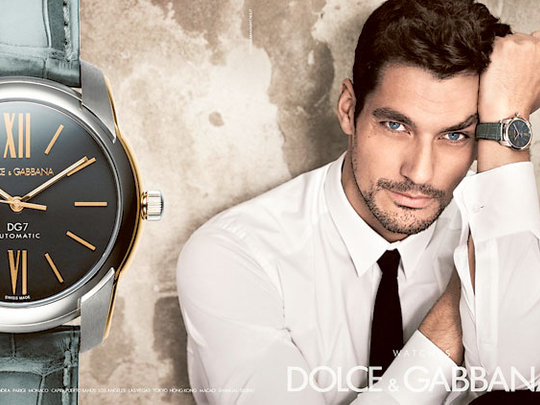
In order to communicate the philosophy behind its first collection of fine watches for men, Dolce & Gabbana has had beautiful photographs taken of David Gandy and other chisel-jawed male models. The men wear the new watches with black tie or semi-nudity. One watch has a quartet of rubies; all look reassuringly expensive. The message is clear: a Dolce & Gabbana watch stands for status, sex and glamour.
But there is more to the brand than meets the eye. When I reach Domenico Dolce, one half of the design duo, at their Milanese atelier, he tells me that his most treasured watch is not a Rolex or Patek Philippe but the modest Bulova he was given for his confirmation. “To us a watch is an item to love, collect, pass down. I love when people wear watches that once belonged to their grandfathers or fathers. I would love if this was the case with our watches in the future.”
Stefano Gabbana went through a stage a few years ago of wearing two watches at once: “A Rolex and a Cartier. Like bracelets. But my most special watch was the Omega I was given for first communion. That was a very symbolic present it is a big occasion, you are becoming a man, and you are given this very grown-up present. It is a nice tradition.”
The success of the brand rests on being a byword for sex appeal, but you don’t build a brand that lasts three decades simply by making hot dresses. The real secret of Dolce & Gabbana is the backstory: a sense of Italian culture, the importance of family and food and ritual, which lends integrity to the aesthetic and a commercial backbone to the glamour. Look closely at any Dolce & Gabbana catwalk and you will see a delicate balance: between black lace and cleavage on the one hand, and dining, religion, opera and Fellini on the other. Look closely in any Dolce & Gabbana store and you will find, behind the corset dresses in the window, expertly tailored skirt suits and immaculate white shirts. Look closely at the new Dolce & Gabbana Precious watch, and you will notice that the rubies on its face look a little like the stained-glass window of a church.
Albert Einstein once said that if you can’t explain something simply, it means you don’t understand it well enough. The art of modern brand building is to construct a sophisticated image that you can sell in simple enough terms for your customer to comprehend. “You have to work very hard behind the scenes, to make a message clear enough for a lot of people to understand,” says Gabbana.
When I ask him about the origin of the current summer womenswear collection, which features sundresses printed with tomatoes and peppers and earrings of dangling farfalle pasta, he tells me he had the idea “when my momma was cooking lunch, and she was wearing an apron with a print of lemons and peppers”.
“I said, ‘Momma, I need your apron’, and I took it to Domenico, to show him, and he loved the idea.”
It may or may not be the hand-on-heart truth: either way, it is a perfect Dolce & Gabbana story. Gabbana lists the ingredients of the brand as “family first of all, then love and sex, then food”. (It is me who makes him line them in order, and he protests that “all these things are linked together, in our culture, and in what it means to us to enjoy life.”)
Later, when I ask Dolce for his recipe for the brand, he tells me: “my order would be: Italy, family, glamour, cinema”.
“And always sensuality: to convey through our clothes the passionate and sensual side of a woman.”
The accepted wisdom is that the Milanese Gabbana (taller, more hair) is the outgoing one and the Sicilian Dolce is the more soulful, tailoring-focused one. It has become shorthand for the label’s yin and yang. “This is a bit of an urban myth,” Dolce says. “We are actually very similar,” agrees Gabbana. “How could we work together for so long otherwise?”
The couple were lovers, as well as collaborators and business partners, for 25 years until 2005. They remain close friends as well as the closest of colleagues: they holiday together at their house in Portofino, and eat lunch together almost every working day. They portray this intriguing arrangement as the most natural in the world. “We loved each other for many years,” says Gabbana, “and now there is no longer love, but there is respect, friendship, affection, the knowledge and reciprocated understanding that only years of a life lived together can give.”
So infectious is the positive message beamed out from Dolce & Gabbana HQ that it seems churlish to blight the rosy picture, but the brand does face challenges. Last year’s acquittal on a charge of tax evasion was overthrown by the Italian equivalent of the supreme court, but it now seems likely that the pair may face another trial, perhaps on a lesser charge of tax avoidance. Last year’s decision to close the cheaper DG line and focus on the Dolce & Gabbana brand has in effect restricted the company to the higher end of the market, which protects the image in the long term but cuts off a source of ready cash in the short term.
Right now, both Dolce and Gabbana are focused on a busy June. The new watches will be followed into stores by a new range of childrenswear; Milan menswear week is on the horizon. This is a special time of year for Italians, says Gabbana, “because holidays are on the horizon”.
But even in Portofino, a megabrand never sleeps. “If we have finished one project then I am happy, because I can start to plan the next,” says Dolce. “I never want to stop.”
Guardian News & Media Ltd








